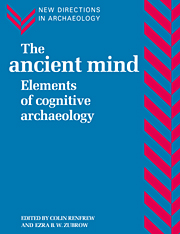Book contents
- Frontmatter
- Contents
- List of figures
- List of tables
- List of contributors
- Preface
- PART I INTRODUCTION
- PART II THE INTERDISCIPLINARY UNDERPINNING
- PART III APPROACHES TO CULT PRACTICE AND TRANSCENDENTAL BELIEF SYSTEMS
- 6 The archaeology of religion
- 7 Ancient Zapotec ritual and religion: an application of the direct historical approach
- 8 The meaning of death: funerary beliefs and the prehistorian
- 9 Prehistoric cognition and the science of archaeology
- PART IV PREHISTORIC CONCEPTIONS OF SPACE AND TIME
- PART V THE MATERIAL BASIS OF COGNITIVE INFERENCE: TECHNOLOGY
- PART VI THE MATERIAL BASIS OF COGNITIVE INFERENCE: WRITING SYSTEMS
- PART VII CONCLUSION
- Index
6 - The archaeology of religion
Published online by Cambridge University Press: 03 December 2009
- Frontmatter
- Contents
- List of figures
- List of tables
- List of contributors
- Preface
- PART I INTRODUCTION
- PART II THE INTERDISCIPLINARY UNDERPINNING
- PART III APPROACHES TO CULT PRACTICE AND TRANSCENDENTAL BELIEF SYSTEMS
- 6 The archaeology of religion
- 7 Ancient Zapotec ritual and religion: an application of the direct historical approach
- 8 The meaning of death: funerary beliefs and the prehistorian
- 9 Prehistoric cognition and the science of archaeology
- PART IV PREHISTORIC CONCEPTIONS OF SPACE AND TIME
- PART V THE MATERIAL BASIS OF COGNITIVE INFERENCE: TECHNOLOGY
- PART VI THE MATERIAL BASIS OF COGNITIVE INFERENCE: WRITING SYSTEMS
- PART VII CONCLUSION
- Index
Summary
Any attempt to encompass the archaeology of mind must inevitably consider the archaeological approach towards religion. For if the archaeology of mind, as envisaged in chapter 1, may be considered in terms of a series of functions of the symbol, of various ways in which symbols may operate, the role of symbols in coping with the unknown and with the supernatural is surely one of the more significant (see Renfrew and Bahn 1991: 358–63). But there is the danger here that we may carry to the inquiry our own culturally-encapsulated, and therefore perhaps stereotyped, view of what religion is. Through our acquaintance, in the first instance, with the great religions of the Book (Judaism, Christianity, Islam), all of which proclaim a unitary deity, we undoubtedly begin from a very special viewpoint. Even some acquaintance with other great, contemporary faiths such as the Buddhist, Hindu, Jain and Zoroastrian, serves in some ways to reinforce the impression of coherently codified (and thus literate), authoritative systems of belief, operating often in an urban context. A preliminary knowledge of the religious systems and the pantheons of Ancient Egypt, Greece and Rome might, at first, reinforce this view of textbased, well-delineated and formalized structures of belief. Clearly, however, the studies of cultural anthropologists have much to tell us about the religious systems of non-urban societies and of social groups operating on a basis of band or tribal organisation, so that some of these preconceptions can be counteracted and the effects of literacy discounted.
- Type
- Chapter
- Information
- The Ancient MindElements of Cognitive Archaeology, pp. 47 - 54Publisher: Cambridge University PressPrint publication year: 1994
- 70
- Cited by



